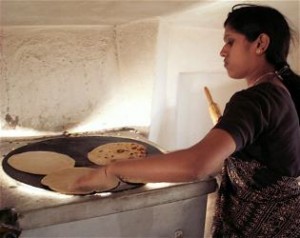
Solar cooking’s potential highlighted at recent conferences in India
 Two conferences held this winter in India highlighted the importance of solar cooking in reducing indoor air pollution, deforestation, black carbon and the danger faced by women who must forage for wood. “Beyond Firewood”, sponsored by the Commission for Refugee Women and Children, focused primarily on fuel-efficient stoves. There were, however, a few intrepid solar cookers present to carry the flag for solar cooking including Deepak and Shirin Gadhia of ICNEER in India. The couple has done more than anyone to spread commercially viable solar cooking devices in that country.
Two conferences held this winter in India highlighted the importance of solar cooking in reducing indoor air pollution, deforestation, black carbon and the danger faced by women who must forage for wood. “Beyond Firewood”, sponsored by the Commission for Refugee Women and Children, focused primarily on fuel-efficient stoves. There were, however, a few intrepid solar cookers present to carry the flag for solar cooking including Deepak and Shirin Gadhia of ICNEER in India. The couple has done more than anyone to spread commercially viable solar cooking devices in that country.
My presentation focused on the integrated cooking aspect of the Solar Cooker Project in Iridimi, Chad, which is being funded by Jewish World Watch. While at this conference, I also met Ashok Gadgil of the Lawrence Berkeley laboratory. His students developed the Darfur stove. At my suggestion, his students have decided this year to conduct research on improving the solar box cooker.
The Solar Food Processing Network organized a second conference in central India in early January. The most remarkable aspect of this conference was the amazingly simple solar thermal technology that has been developed to process food for home consumption and for commercial use. The most amazing of these was the Scheffler community parabolic solar cooker, which is used every day to feed the 300 young women studying at the Barli Insitute where the conference was held. This device allows the female students to cook inside a clean, ventilated smoke-free kitchen over a solar thermal source of heat which reaches more than 450 degrees centigrade. The potential for the commercial use of solar cooking is limited only by the sunshine and our imaginations.
Photo: Student cooking chapattis inside the kitchen using only sunshine.



